Articles
- Page Path
- HOME > J Korean Acad Nurs > Volume 44(5); 2014 > Article
-
Original Article
- Bone Mineral Density, Biochemical Bone Turnover Markers and Factors associated with Bone Health in Young Korean Women
- Young-Joo Park, Sook Ja Lee, Nah-Mee Shin, Hyunjeong Shin, Yoo-Kyung Kim, Yunjung Cho, Songi Jeon, Inhae Cho
-
Journal of Korean Academy of Nursing 2014;44(5):504-514.
DOI: https://doi.org/10.4040/jkan.2014.44.5.504
Published online: October 31, 2014
1College of Nursing, Korea University, Seoul, Korea.
2Department of Home Economics Education, College of Education, Korea University, Seoul, Korea.
3Department of Laboratory Medicine, College of Medicine, Korea University, Seoul, Korea.
4Department of Nursing, Graduate School, Korea University, Seoul, Korea.
- Address reprint requests to: Jeon, Songi. College of Nursing, Korea University, 145 Anam-ro, Seongbuk-gu, Seoul 136-701, Korea. Tel: +82-2-3290-4906, Fax: +82-2-927-4676, j50792@korea.ac.kr
© 2014 Korean Society of Nursing Science
This is an Open Access article distributed under the terms of the Creative Commons Attribution NoDerivs License. (http://creativecommons.org/licenses/by-nd/4.0/) If the original work is properly cited and retained without any modification or reproduction, it can be used and re-distributed in any format and medium.
Abstract
-
Purpose
- This study was done to assess the bone mineral density (BMD), biochemical bone turnover markers (BTMs), and factors associated with bone health in young Korean women.
-
Methods
- Participants were 1,298 women, ages 18-29, recruited in Korea. Measurements were BMD by calcaneus quantitative ultrasound, BTMs for Calcium, Phosphorus, Osteocalcin, and C-telopeptide cross-links (CTX), body composition by physical measurements, nutrients by food frequency questionnaire and psychosocial factors associated with bone health by self-report.
-
Results
- The mean BMD (Z-score) was -0.94. 8.7% women had lower BMD (Z-score≤-2) and 14.3% women had higher BMD (Z-score≥0) than women of same age. BTMs were not significantly different between high-BMD (Z-score≥0) and low-BMD (Z-score<0) women. However, Osteocalcin and CTX were higher in women preferring caffeine intake, sedentary lifestyle and alcoholic drinks. Body composition and Calcium intake were significantly higher in high-BMD. Low-BMD women reported significantly higher susceptibility and barriers to exercise in health beliefs, lower bone health self-efficacy and promoting behaviors.
-
Conclusion
- Results of this study indicate that bone health of young Korean women is not good. Development of diverse strategies to intervene in factors such as exercise, nutrients, self-efficacy, health beliefs and behaviors, shown to be important, are needed to improve bone health.
This research was supported by the Basic Science Research Program through the National Research Foundation of Korea (NRF) funded by the Ministry of Education, Science and Technology (No. NRF-2012R1A1A3013540).
- 1. Shin CS, Choi HJ, Kim MJ, Kim JT, Yu SH, Koo BK, et al. Prevalence and risk factors of osteoporosis in Korea: A community-based cohort study with lumbar spine and hip bone mineral density. Bone. 2010;47(2):378–387. http://dx.doi.org/10.1016/j.bone.2010.03.017ArticlePubMed
- 2. Kim KH, Lee K, Ko YJ, Kim SJ, Oh SI, Durrance DY, et al. Prevalence, awareness, and treatment of osteoporosis among Korean women: The Fourth Korea National Health and Nutrition Examination Survey. Bone. 2012;50(5):1039–1047. http://dx.doi.org/10.1016/j.bone.2012.02.007ArticlePubMed
- 3. NIH Consensus Development Panel on Osteoporosis Prevention Diagnosis and Therapy. Osteoporosis prevention, diagnosis, and therapy. JAMA. 2001;285(6):785–795.ArticlePubMed
- 4. Hernandez CJ, BeaupréGS , Carter DR. A theoretical analysis of the relative influences of peak BMD, age-related bone loss and menopause on the development of osteoporosis. Osteoporos Int. 2003;14(10):843–847. http://dx.doi.org/10.1007/s00198-003-1454-8ArticlePubMedPDF
- 5. Bonjour JP, Chevalley T, Rizzoli R, Ferrari S. Gene-environment interactions in the skeletal response to nutrition and exercise during growth. Med Sport Sci. 2007;51:64–80. http://dx.doi.org/10.1159/0000103005ArticlePubMed
- 6. Rizzoli R, Bianchi ML, Garabedian M, McKay HA, Moreno LA. Maximizing bone mineral mass gain during growth for the prevention of fractures in the adolescents and the elderly. Bone. 2010;46(2):294–305. http://dx.doi.org/10.1016/j.bone.2009.10.005ArticlePubMed
- 7. Robinson ML, Winters-Stone K, Gabel K, Dolny D. Modifiable lifestyle factors affecting bone health using calcaneus quantitative ultrasound in adolescent girls. Osteoporos Int. 2007;18(8):1101–1107. http://dx.doi.org/10.1007/s00198-007-0359-3ArticlePubMedPDF
- 8. Choi HJ. Risk factors and assessment of low bone mass in the young adult female. Korean J Fam Med. 2009;30(12):924–933. http://dx.doi.org/10.4082/kjfm.2009.30.12.924Article
- 9. Koo JO, Ahn HS, Yoo SY. Study of bone mineral density, body composition and dietary habits of 20-30 years women. Korean J Community Nutr. 2008;13(4):489–498.
- 10. Cho DS, Lee JY. Bone mineral density and factors affecting in female college students. Korean J Women Health Nurs. 2008;14(4):297–305. http://dx.doi.org/10.4069/kjwhn.2008.14.4.297Article
- 11. Kim MS, Koo Jo. Analysis of factors affecting bone mineral density with different age among adult women in Seoul area. Korean J Community Nutr. 2007;12(5):559–568.
- 12. McLeod KM, Johnson CS. A systematic review of osteoporosis health beliefs in adult men and women. J Osteoporos. 2011;2011:197454. http://dx.doi.org/10.4061/2011/197454ArticlePubMedPMCPDF
- 13. Waller J, Eriksson O, Foldevi M, Kronhed AC, Larsson L, Löfman O, et al. Knowledge of osteoporosis in a Swedish municipality-a prospective study. Prev Med. 2002;34(4):485–491. http://dx.doi.org/10.1006/pmed.2002.1007ArticlePubMed
- 14. Park YJ, Lee SJ, Shin NM, Kang HC, Kim SH, Kim T, et al. Structural model for osteoporosis preventive behaviors in postmenopausal women: Focused on their own BMD awareness. Korean J Adult Nurs. 2013;25(5):527–538.ArticlePDF
- 15. Champion VL, Skinner CS. The health belief model. In: Glanz K, Rimer BK, Viswanath K, editors. Health behavior and health education: Theory, research, and practice. 4th ed. San Francisco, CA: Jossey-Bass; 2008. p. 45–65.
- 16. Kim KK, Horan M, Gendler P, Patel M. Osteoporosis health belief, selfefficacy, and knowledge tests. In: Redman BK, editor. Measurement tools in patient education. New York, NY: Springer Publishing Company; 1998. p. 307–318.
- 17. Bandura A. The explanatory and predictive scope of self-efficacy theory. J Soc Clin Psychol. 1986;4(3):359–373. http://dx.doi.org/10.1521/jscp.1986.4.3.359Article
- 18. Horan ML, Kim KK, Gendler P, Froman RD, Patel MD. Development and evaluation of the osteoporosis self-efficacy scale. Res Nurs Health. 1998;21(5):395–403.ArticlePubMed
- 19. Chon MY, Jeon HW, Kim MH. Bone mineral density and factors influencing bone mineral density in college women. Korean J Women Health Nurs. 2012;18(3):190–199. http://dx.doi.org/10.4069/kjwhn.2012.18.3.190ArticlePubMed
- 20. Yoon JS, Lee MJ. Calcium status and bone mineral density by the level of sodium intake in young women. Korean J Community Nutr. 2013;18(2):125–133. http://dx.doi.org/10.5720/kjcn.2013.18.2.125Article
- 21. Bae YJ, Yeon JY. Evaluation of sodium intake and relationship between sodium intake and the bone mineral density of female university students. J East Asian Soc Diet Life. 2011;21(5):625–636.
- 22. Zittermann A, Geppert J, Baier S, Zehn N, Gouni-Berthold I, Berthold HK, et al. Short-term effects of high soy supplementation on sex hormones, bone markers, and lipid parameters in young female adults. Eur J Nutr. 2004;43(2):100–108. http://dx.doi.org/10.1007/s00394-004-0447-5ArticlePubMedPDF
- 23. Kim DY. Biochemical markers of bone turnover. Korean J Nucl Med. 1999;33(4):341–351.
- 24. Chang SF, Hong CM, Yang RS. Cross-sectional survey of women in Taiwan with first-degree relatives with osteoporosis: Knowledge, health beliefs, and preventive behaviors. J Nurs Res. 2007;15(3):224–232.ArticlePubMed
- 25. Estok PJ, Sedlak CA, Doheny MO, Hall R. Structural model for osteoporosis preventing behavior in postmenopausal women. Nurs Res. 2007;56(3):148–158. http://dx.doi.org/10.1097/01.NNR.0000270031.64810.0cArticlePubMed
- 26. The Korean Nutrition Society. Dietary reference intakes for Koreans. Seoul: Author; 2010.
- 27. Kwon SM, Lee BK, Kim HS. Relation between nutritional factors and bone status by broadband ultrasound attenuation among college students. J Korean Soc Food Sci Nutr. 2009;38(11):1551–1558. http://dx.doi.org/10.3746/jkfn.2009.38.11.1551Article
- 28. Howe TE, Shea B, Dawson LJ, Downie F, Murray A, Ross C, et al. Exercise for preventing and treating osteoporosis in postmenopausal women. Cochrane Database Syst Rev. 2011;7:CD000333. http://dx.doi.org/10.1002/14651858.CD000333.pub2Article
- 29. Marrone JA, Maddalozzo GF, Branscum AJ, Hardin K, Cialdella-Kam L, Philbrick KA, et al. Moderate alcohol intake lowers biochemical markers of bone turnover in postmenopausal women. Menopause. 2012;19(9):974–979. http://dx.doi.org/10.1097/gme.0b013e31824ac071ArticlePubMed
- 30. Berg KM, Kunins HV, Jackson JL, Nahvi S, Chaudhry A, Harris KA Jr, et al. Association between alcohol consumption and both osteoporotic fracture and bone density. Am J Med. 2008;121(5):406–418. http://dx.doi.org/10.1016/j.amjmed.2007.12.012ArticlePubMedPMC
- 31. Song MS, Yoo YK, Choi CH, Kim NC. Effects of nordic walking on body composition, muscle strength, and lipid profile in elderly women. Asian Nurs Res. 2013;7(1):1–7.Article
REFERENCES
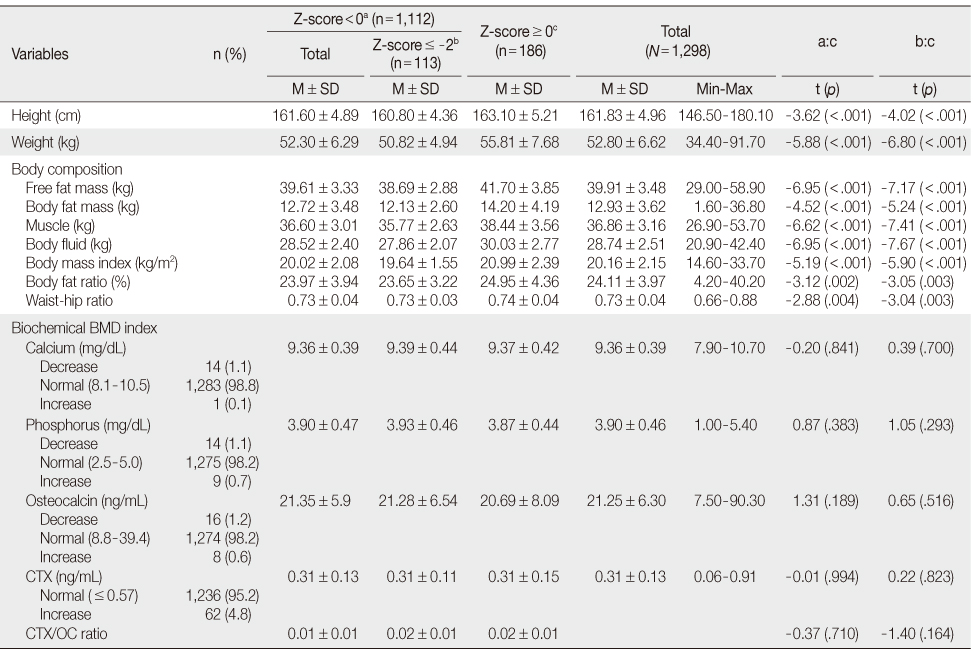
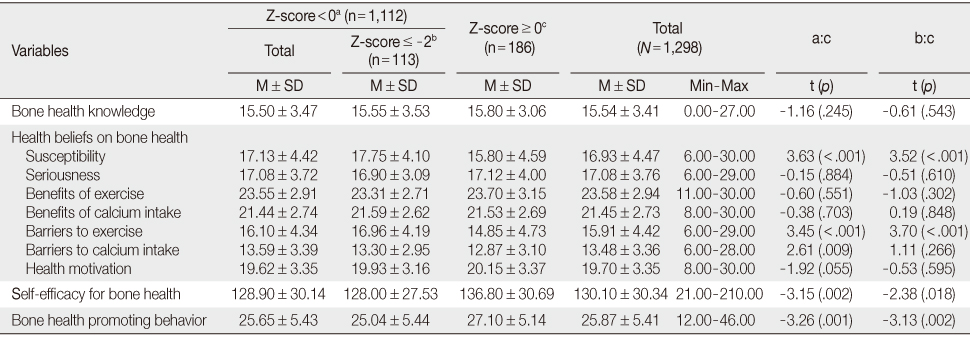
Figure & Data
REFERENCES
Citations

- Quality Characteristics of Imported Specialty Coffee According to Origin
So-Young Lee, Myung-Ryun Han, Ae-Jung Kim
Asian Journal of Beauty and Cosmetology.2019; 17(4): 533. CrossRef - Dietary protein and bone health across the life-course: an updated systematic review and meta-analysis over 40 years
A. L. Darling, R. J. F. Manders, S. Sahni, K. Zhu, C. E. Hewitt, R. L. Prince, D. J. Millward, S. A. Lanham-New
Osteoporosis International.2019; 30(4): 741. CrossRef - Study on the osteoporosis knowledge, concern about osteoporosis factors, and health behavior to prevent osteoporosis of women in Jeonbuk area
Hyun Ju Lee, Jeong Ok Rho
Journal of Nutrition and Health.2018; 51(6): 526. CrossRef - Application and Effect of Mobiletype-Bone Health Intervention in Korean Young Adult Women with Low Bone Mass: A Randomized Control Trial
Young-Joo Park, Sook-Ja Lee, Nah-Mee Shin, Hyunjeong Shin, Songi Jeon, Jungwoo Lee, Inhae Cho
Asian Nursing Research.2017; 11(1): 56. CrossRef - Relationship between Coffee Consumption and Metabolic Syndrome in Korean Adults: Data from the 2013–2014 Korea National Health and Nutrition Examination Survey
Hyekyung Shin, John A. Linton, Yujin Kwon, Yohan Jung, Bitna Oh, Sinae Oh
Korean Journal of Family Medicine.2017; 38(6): 346. CrossRef - A path analysis of factors influencing eating problem among young female adults
Bo-Kyoung Cha
Journal of Nutrition and Health.2017; 50(6): 615. CrossRef - Relationship between Bone-Specific Physical Activity Scores and Measures for Body Composition and Bone Mineral Density in Healthy Young College Women
SoJung Kim, Wi-Young So, Jooyoung Kim, Dong Jun Sung, Karen Hind
PLOS ONE.2016; 11(9): e0162127. CrossRef - Development of a Smartphone Application for Promoting Bone Health in Korean Young Adult Women: A Pilot Study
Young-Joo Park, Sook-Ja Lee, Nah-Mee Shin, Hyunjeong Shin, Sungjin Yoon, Songi Jeon, Inhae Cho
Korean Journal of Adult Nursing.2015; 27(4): 459. CrossRef
Demographic Characteristics and Bone Mineral Density of Young Korean Women (N=1,298)
SES=Socioeconomic status; BQI=Bone quality index; SOS=Speed of sound; BUA=Broadband ultrasound attenuation.
Body Composition and Biochemical Bone Turnover Markers by Bone Mineral Density of Young Korean Women (N=1,298)
BMD=Bone mineral density; CTX=C-telopeptide of collagen cross-links; CTX/OC ratio=C-telopeptide of collagen cross-links/Osteocalcin ratio.
Mean Difference of Bone Health Knowledge, Health Beliefs and Bone Health Promoting Behavior according to Bone Mineral Density (N=1,298)
Health Habits, Bone Mineral Density and Bone Turnover Markers of Young Korean Women (N=1,298)
Means with different superscript letters are significantly different, p<.05 by Duncan's multiple comparison test; BTMs=Bone turnover markers; CTX=C-telopeptide of collagen cross-links.
Energy and Nutrients Intake according to Bone Mineral Density of Young Korean Women (N=1,157)
SES=Socioeconomic status; BQI=Bone quality index; SOS=Speed of sound; BUA=Broadband ultrasound attenuation.
BMD=Bone mineral density; CTX=C-telopeptide of collagen cross-links; CTX/OC ratio=C-telopeptide of collagen cross-links/Osteocalcin ratio.
Means with different superscript letters are significantly different,
 KSNS
KSNS
 E-SUBMISSION
E-SUBMISSION
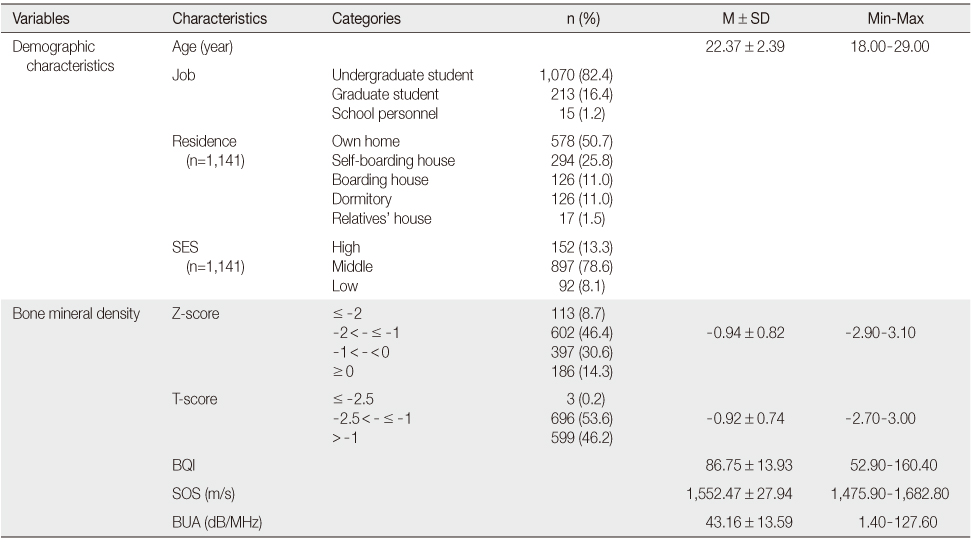
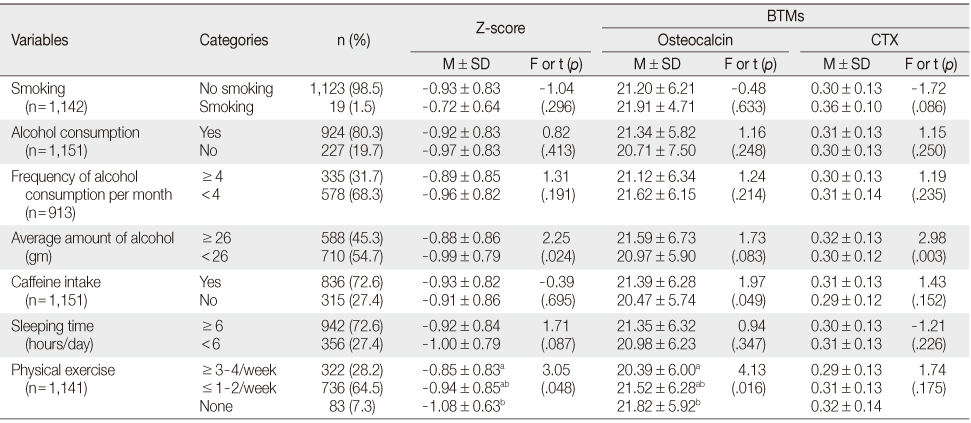
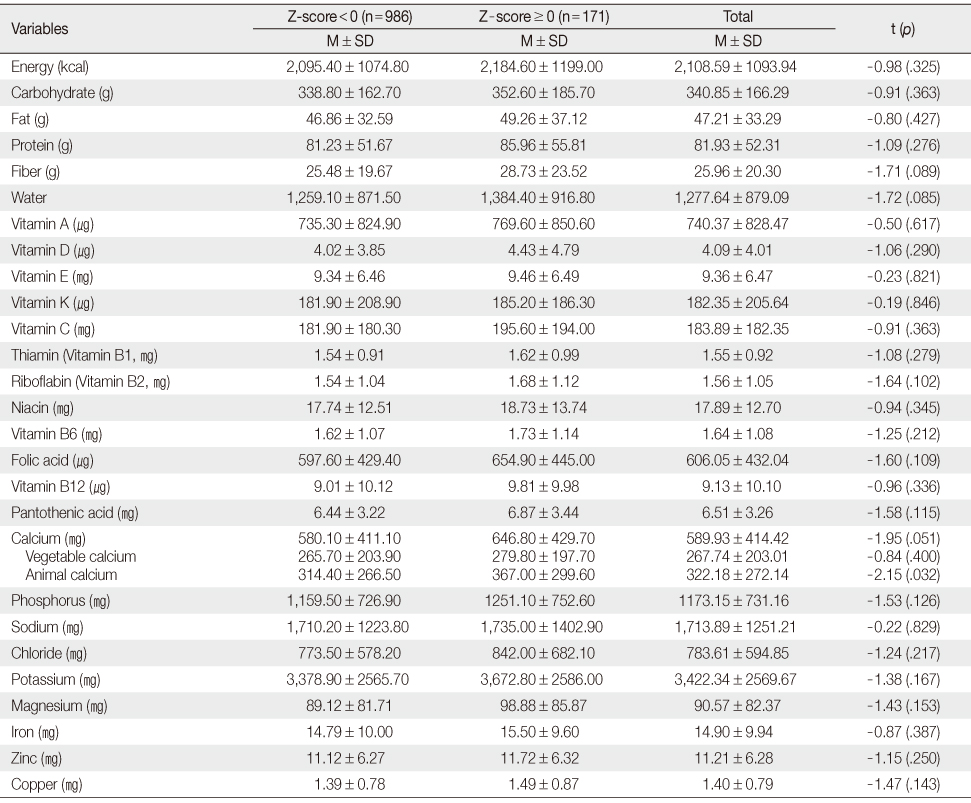
 Cite
Cite

